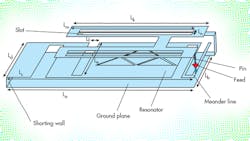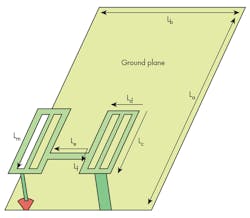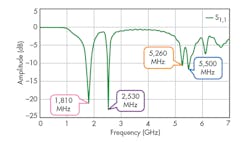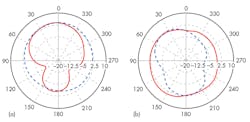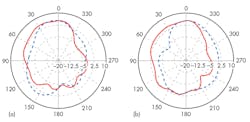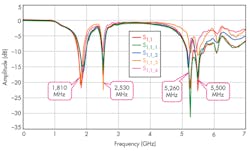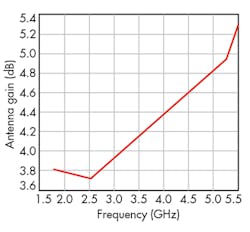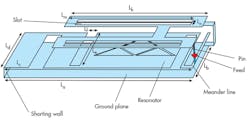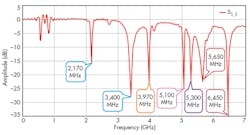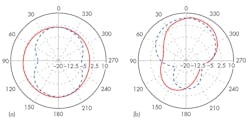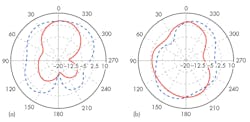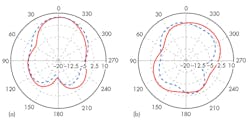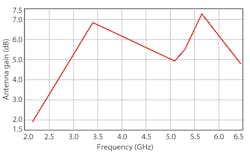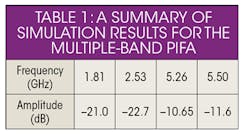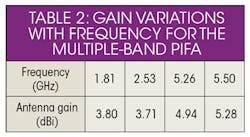Flexible PIFA Antenna Serves Multiple Wireless Bands
Proliferation of wireless services makes an antenna capable of operation at multiple frequency bands very attractive. For that reason, a planar inverted F antenna (PIFA) was designed for wireless network applications at 1,810, 2,530, 5,260, and 5,500 MHz. A PIFA is a compact form of microstrip antenna (shaped like an inverted letter “f”) that is commonly used in wireless devices, such as cellular telephones. The goal of the design efforts was to reduce the size of the PIFA antenna structure while supporting multiple applications at commonly used frequencies, including for DCS, LTE, UMTS, WiMAX, and wireless-local-area-network (WLAN) systems.
Since modern electronic communications products typically support several wireless standards, such as Third-Generation (3G) or Fourth-Generation (4G) cellular communications and Wi-Fi, availability of a compact antenna capable of operating at multiple wireless bands can mean a significant savings in volume within the final product design. By developing an antenna covering five different radio bands, a great deal of flexibility is provided with a relative small structure. The design was simulated with commercial computer-aided-engineering (CAE) software; simulations show radiation patterns, return loss, and gain with respectable performance in all five bands.
Antennas for modern communications devices must support a variety of global communication standards and services. The antennas for these modern communication devices should be capable of operating within as many bands as possible with acceptable return loss and radiation patterns in order to serve multiple cellular and noncellular communication applications. In addition to good electrical performance, the antennas should have compact, low-profile structures that are robust, lightweight, flexible, and easy to manufacture.1-10 The rapid expansion of wireless communications has created a strong demand for antennas that are small in size and can operate across multiple wireless frequency bands to meet the requirements of modern mobile wireless electronic devices, such as smartphones.2-8
Through careful design and CAE simulation, it was possible to develop a new PIFA covering three different wireless frequency bands: 5.26 GHz for WLANs, 2.53 GHz for Long-Term-Evolution (LTE) cellular communications, and 1.81 GHz for DCS. In spite of its multiple-band operation, the antenna achieves attractive beamwidth with good radiation efficiency in all three frequency bands.
The antenna consists of a metal ground plane with overall size of 90 × 38 × 8.05 mm and two resonators using two parallel slots in support of multiple resonant frequencies (Fig. 1). A microstrip circuit connects the resonators to the ground plane. Performance can be optimized by making modifications to the slots.
The fundamental resonant frequency, fr, of such an antenna structure can be found from:
fr = c/[4(h + L)]
where
fr is the fundamental resonant frequency;
c is the velocity of light in free space;
L is the length of the antenna; and
h is the height of the antenna.
The PIFA was simulated by means of Microwave Studio simulation software from Computer Simulation Technology. Simulation results were obtained for the antenna for DCS, LTE, and WLAN wireless frequency bands at resonant frequencies of 1,810, 2,530, 5,260, and 5,500 MHz (Fig. 2 and Table 1).
Antenna radiation patterns are usually presented in two orthogonal planes: the E- and H-plane radiation patterns relative to the main direction of propagation. The E-plane plots show the locus of points in free space representing the radiated electric € field, while the H-plane shows the points in free space representing the radiated magnetic field (H).1
Figures 3(a) and (b) show the polar radiation patterns for the PIFA for frequencies of 1.81 and 2.53 GHz, respectively, with resonances within the E and H planes. It can be seen that the radiation patterns are directed along the 0 deg., 0 deg. axis for 1.81 GHz and the 180 deg., 150 deg. axis for 2.53 GHz, resulting in an omnidirectional radiation pattern.
Figures 4(a) and (b) show the polar radiation patterns for the PIFA for frequencies of 5.26 and 5.50 GHz, respectively, with resonances within the E and H planes. It can be seen that the radiation patterns are directed along the 0 deg., 30 deg. axis for 5.26 GHz and the 0 deg., 0 deg. axis for 5.50 GHz. The width of the antenna was changed to study the effects of the mechanical change, and these can be seen in Fig. 5.
Following application of the miniaturization technique, the return loss of the PIFA shows an improvement. The antenna design exhibited increasing gain with increasing resonance frequency (Fig. 6). Table 2 provides details of these antenna gain variations versus frequency.
The antenna was implemented to cover six frequency bands with far-field radiation patterns, using meander lines and Sierpenski textile material. Such flexible antennas are suitable for body-worn antenna designs, with multiple-band coverage for the one antenna minimizing the need for additional antennas for wireless coverage. Simulations of the flexible PIFA antenna show acceptable performance for all proposed frequency bands. The overall dimensions of the ground plane widths are 38 mm to 30 mm to 0.05 mm (Fig. 7).
The authors simulated the performance of the multiple-band PIFA in six frequency bands for mobile-phone applications for UMTS (1,920 to 2,170 MHz); WiMAX (3,400 to 3,600 MHz); HiperLAN High Performance Radio LAN (HiperLAN; with frequency bands of 1,710 MHz to 2,170 MHz, as well as 4,800 to 5,800 MHz); 3G (1,885 to 2,200 MHz); and ultrawideband (UWB) applications (6500 MHz).13
Simulations performed with the CST software in Figs. 8 through 10 cover DC to 7 GHz. The results show that the PIFA provides amplitude peaks in the radiation patterns at many different frequencies: -16 dB for 2.17 GHz, -28 dB for 3.40 GHz, -25 dB for 5.10 GHz, -22.2 dB for 5.30 GHz, -22 dB for 5.65 GHz, and -35 dB for 6.45 GHz.1
The radiation patterns in Figs. 9(a) and (b) demonstrate the dependence of return loss on frequency for the PIFA. The results show the presence of resonances at the frequencies 2.17, 3.40, 5.10, 5.30, 5.65, and 6.45 GHz, with S11 parameter levels of -16 dB, -28 dB, -25 dB, -22.2,- 22 dB, and -35 dB, respectively. show the radiation patterns in polar (E, H) coordinates for 2.17 and 3.40 GHz, with the angular degrees the patterns are directed along (180, 150 deg.) for 2.17 GHz and (0, 0 deg.) for 3.40 GHz.
Nassima Belgacem, Ph.D. Student
Telecommunications Laboratory of Tlemcen
Mehadji Abri, Doctor
Telecommunications Laboratory of Tlemcen
Hadjira Abri, Doctor
STIC Laboratory of Tlemcen
Telecommunications Department, Faculty of Technology, University of Tlemcen, Tlemcen, Algeria
Wahiba Belgacem, Engineer
Agence Spatiale Algérienne, Oran, Algeria
References
1. M. Abri, N. Belgacem, and W. Belgacem, “New GSM, DCS, and GSM/DCS PIFA Antenna Designs for Wireless Networks Applications,” International Journal of Information & Network Security (IJINS), Vol. 2, No. 4, August 2013, pp. 305~310; ISSN: 2,089-3,299, 2013.
2. A.A.H. Azremi, N.A. Saidatul, R.B. Ahmad, and P.J. Soh, “Parametric Study of Broadband Planar Inverted F Antenna (PIFA) for WLAN Application,” 2008 International Conference on Electronic Design, December 1-3, 2008, Penang, Malaysia.
3. L. Freytag, “Conception, Réalisation, et Caractérisation dâAntennes Pour Stations de Base des Réseaux de Télécommunication Sans Fil,” Thèse de doctorat université de Limoges, Limoges, France, Novembre 2004.
4. Y. Yuan, X. Wang, X. Chen, and Y. Jun sheng, “Novel Diversity/MIMO PIFA Antenna With Broadband Circular Polarization for Multimode Satellite Navigation,” IEEE Antennas and Wireless Propagation Letters, Vol. 11, 2012, pp. 65-68.
5. G.K. H. Lui and R.D. Murch, “Compact dual-frequency PIFA design using LC resonators,” IEEE Transactions on Antennas & Propagation, Vol. 49, No. 7, July 2001, pp. 1,016-1,019.
6. N. Behdad and K. Sarabandi, “A varactor-tuned dual-band slot antenna,” IEEE Transactions on Antennas & Propagation, Vol. 54, No. 2, February 2006, pp. 401-408.
7. K.-L. Wong, W.-Y. Chen, and T-W. Kang, “On-board printed coupled-fed loop antenna in close proximity to the surroung ground plane for penta-band WWAN mobile phone,” IEEE Transactions on Antennas & Propagation, Vol. 59, No. 3, March 2011, pp. 751-757.
8. H. Morishita, Y. Kim, and K. Fujimoto, “Design concept of antennas for small mobile terminals and the future perspective,” IEEE Antennas & Propagation Magazine, October 2002, Vol. 44, No. 5, October 2002, pp. 30-43.
9. S. Tourette, G. Collin, P. Le Thuc, C. Luxey, and R. Staraj, “Small Meandered PIFA Associated with SAW Passive Sensor for Monitoring Inner Temperature of a Car Exhaust Header,” 2009 IEEE Transaction on Antennas & Propagation, Vol. 57, No. 9, September 2009.
10. Rashid Ahmad Bhatti, Yun-Taek Im, and Seong-Ook Park, “Compact PIFA for Mobile Terminals Supporting Multiple Cellular and Non-Cellular Standards,” IEEE Transaction on Antennas and Propagation, Vol. 57, No. 9, September 2009.
11. K.R. Boyle and P.G. Steeneken, “A Five-Band Reconfigurable PIFA for Mobile Phones,” IEEE Transactions on Antennas & Propagation, Vol. 55, No. 11, November 2007.
12. D.M. Nashaat, H.A. Elsadek, and H. Ghali, “Single feed compact quad-band PIFA antenna for Wireless Communication Applications,” IEEE Transactions on Antennas & Propagation, Vol. 53, No. 8, August 2005, pp. 2,631-2,635.
13. N.A. Saidatul, A.A.H. Azremi, R.B. Ahmad, P.J. Soh, and F. Malek “A Development of Fractal PIFA (Planar Inverted F Antenna) with Bandwidth Enhancement for Mobile Phone Applications,” 2009 Loughborough Antennas and Propagation Conference.
Looking for parts? Go to SourceESB.
